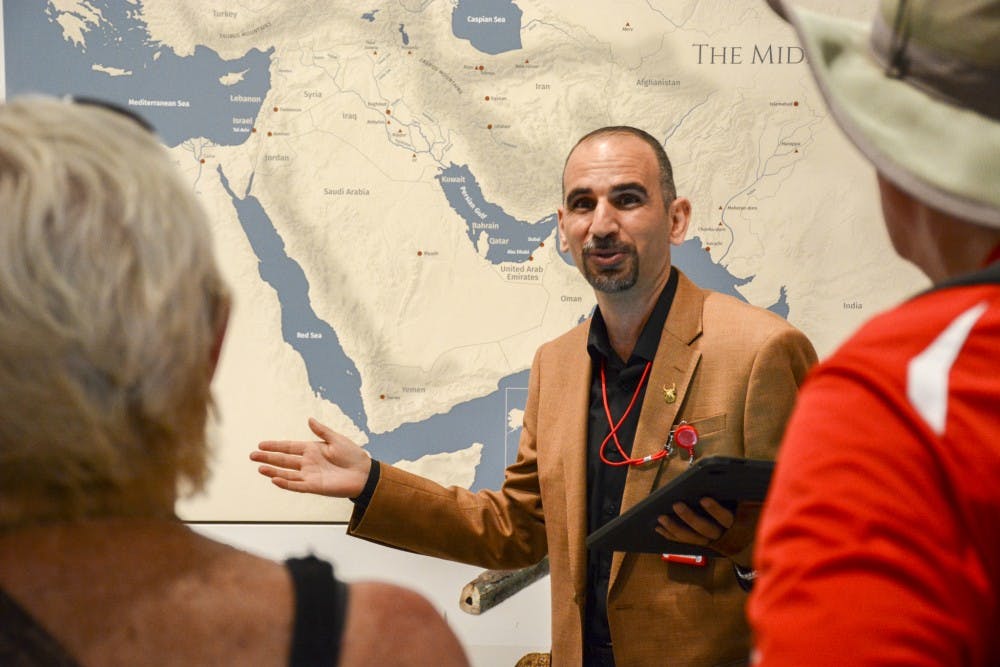On a recent Saturday afternoon, Yaroub Al–Obaidi, an Iraqi native, gathered his group of tourists eagerly waiting at the Middle East Galleries. In an animated one–hour trip through the gallery spaces, he revealed countless Penn Museum artifacts, drawing upon his own experiences to add a personal touch.
Having moved with his family from Iraq to the United States two years ago, Al–Obaidi joined a team of three global guides this past February as a part of the Global Guides Program at the Penn Museum. The Program is aimed at promoting a better understanding of not only Middle East galleries, but also the culture behind the artwork. Since the guides are immigrants and refugees themselves, they are not your typical guides. In addition to sharing historical knowledge about the artifacts on display, they relate the objects to their personal experiences and stories to construct unique narratives that shed light on the artifacts from their home countries.
“Right after we opened up our brand new Middle East galleries in May 2018, as part of the big building transformation at the Penn Museum, which is to revitalize 75 percent of our public spaces, we also wanted to think about how we could revitalize our interpretation of the spaces,” said Ellen Owens, the Merle–Smith Director of Learning Programs. “And how we can provide experiences that are deeper, richer, and more relatable for the public, rather than mere facts.”
The Museum has a general framework of the good places to stop at on a tour based on the rhythm of the group and the general storyline, but guides get to choose any objects within the stop areas that resonate with them. They share their personal experiences with the audience that are related to the artifacts to illuminate the connections between the ancient and the current world.
One of the artifacts that Al–Obaidi particularly likes is a group of cylinder seals from the Sumerian city–state Ur, which is known today as Tall al Muqayyar, in Iraq. In addition to explaining the story behind the seals, what they meant, and what they were used for, Al–Obaidi explains how seals had been logo concepts 1000 years back, and how his first class at the University of Baghdad was also about logo design. Those ancient cylinder seals were like users’ personal brands, similar to company logo design today which also reflects a brand’s ideology.
Al–Obaidi also relates Mesopotamia, which is situated within the Tigris–Euphrates river system, to his attachment to rivers as he grew up and how living near rivers offers fertile land for populations to grow and thrive. All these conversations are supported by maps and photos. As Al–Obaidi discusses how his life has always been connected to rivers, he shows the audience a photo taken next to the Schuylkill River. To his surprise, the audience looks at the photo as if “it’s their first time seeing Schuylkill.”
“It’s an amazing time every week,” Al–Obaidi added. “I try to build connections with visitors and make them enjoy and engage in the stories, and conveying how my life is connected with rivers is really an effective way.” In engaging with the audience, the personal connections he establishes with the visitors lead to many inviting him to lunch or coffee after the tour. “One of the visitors left a note with his email, saying that he and his wife like[d] the tour so much that they would like to be in touch with me,” he said.
In addition to his role as a guide, Al–Obaidi also works as a community liaison for Swarthmore College in a project called Friends, Peace, and Sanctuary, which is a series of workshops that teach Syrian and Iraqi refugees in Philly the art of design and bookmaking.
Between the two, there has been a surge in interest in Middle Eastern culture. “Both programs bring people together. There’s a huge Middle Eastern population in Philly, but a lot of people don't necessarily have interactions with them,” Owens commented. “We did an evaluation that revealed more than half of the surveyed have informal or no experience with people from the Middle East, and about 20 percent have never interacted with any. But people are interested in learning more about the Middle East, their culture, and food. We didn’t expect such powerful results from the tours. But people do understand their neighbors more and start to connect on a personal level with them.”
The global guides, like a spat of others that intend to reinvigorate museum tours, bring in a variety of perspectives, engaging audience of different expertise levels with deep historical knowledge as well as what the culture is like today through their personal stories.

